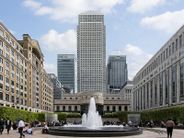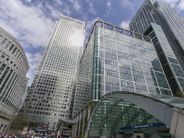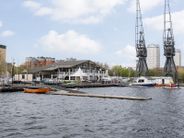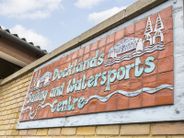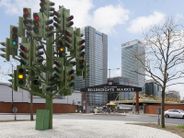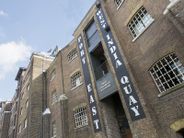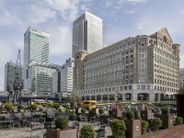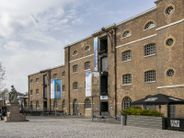
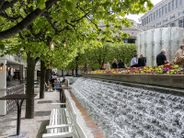
Canary Wharf
Average sold price last 12 months
£500,756
What’s it all about?
Canary Wharf is an iconic part of London's skyline and, while it might be better known as the glass and steel headquarters of London's global financial centre, in the past decade it's also become one of the Capital’s most coveted neighbourhoods. After the glitch that was the property crash of the early 1990s, the transition from derelict ex industrial docks to a thriving business and residential quarter is complete. The area has been helped by excellent travel links – the DLR and Jubilee Line takes you into the City and West End in 10 to 15 minutes, and are two of the most salubrious modes of public transport in London. The newly opened Canary Wharf Elizabeth line station provides swift connections to Liverpool Street in six minutes, Paddington in 17 minutes, and London Heathrow in 45 minutes.
With the introduction of Wood Wharf, Canary Wharf's new residential neighbourhood, Canary Wharf and its surroundings are now home not only to billion pound businesses, but also a rapidly growing number of residents. These locals enjoy a world class selection of restaurants, shops and bars, many of which have waterside locations and fantastic views. It’s not all hustle and bustle, though. Mudchute Farm, just down the road, will keep the kids entertained for hours, and there are several local schools. New residential developments on the Isle of Dogs have opened this area up to a wide range of buyers, from City professionals to young families and first time buyers.
Fact file
- No 32 berth of West Wood Quay was built in 1936 for Fruit Lines Ltd, which imported fruit from the Mediterranean and Canary Islands. At the request of the company the quay and warehouse were given the name Canary Wharf.
- At 770 feet One Canada Square held the record for the tallest building in the UK until the completion of The Shard at 1,014 feet, in 2012.
- From 1926, when the railway closed, to 1987 when the DLR was built, the only public transport accessing the island was buses.
Architecture and property
The urbanisation of the Isle of Dogs took place in the 19th century after the construction of the docks. The island was connected to the rest of London by the London & Blackwall Railway, and in 1902 the ferry to Greenwich was replaced by a foot tunnel, and Island Gardens park was opened. The docks closed progressively during the 1970s, closing the chapter on the area's industrial past. Today another type of industry booms here, and although much of the land was cleared to make way for Canary Wharf's signature skyscrapers, many renovated warehouses still recall the past. Indeed, they've become a benchmark for open plan design and loft living.
Property here consists mainly of apartments, with some spectacular penthouses and riverside developments with fabulous views across the Capital. Combined with a mix of modern townhouses, a few surviving Victorian terraced houses, Edwardian cottage estate type houses and former council flats provide a range of choices.
For house price information please visit the sold data tab.
Going out
Eating: Boisdale of Canary Wharf has outstanding reviews for its modern British cooking and offers a choice of more than 3,000 whiskies, as well as a cigar menu. If you have a yen for modern Japanese cuisine, head to Roka at Canary Wharf, where you can also watch the robata chefs at work. Housed on the water in an eco-friendly pavilion is Hawksmoor Wood Wharf, a steak restaurant with a difference. If you head over to Wood Wharf and you will find an abundance of new places popping up, including Emilia's Pasta and MMy, from the creators of Mercato Metropolitano.
Drinking: Wander through Crossrail Place roof garden into the botanical escape of Pergola on the Wharf, a cocktail bar and restaurant with panoramic views over Canary Wharf’s north dock. If you prefer a bit of competition with your tipple, head to Electric Shuffle, in the hub of Cabot Square. This stunning venue features ten playing areas and two glorious bars perfect for toasting your champions. The Gun on Coldharbour is a favourite with locals, and its full restaurant menu offers upmarket gastropub fare, with oysters as their speciality.
Culture: Top of the list of places to visit is the London Museum Docklands, which has exhibitions focusing on the history of the area. It also offers the chance to take an evening guided ‘ghost walk’ around Docklands.
You might be surprised to know that Canary Wharf is home to London’s largest collection of outdoor public art. With more than 100 stand-alone sculptures and integrated architectural works, discover the full collection free of charge. In addition, Canary Wharf is an events partner of leading cultural institutions including the Royal Opera House, Royal Shakespeare Company.
Local amenities
- Canary Wharf has five shopping malls, with a wide range of shops and boutiques, from Monica Vinader to Zara. For grocery shopping there is a Waitrose in the centre, plus an Asda superstore just a short hop south in Crossharbour.
- Billingsgate Fish Market is just up the road in Poplar and is open to the public as well as to trade customers – get there early though, as it’s all over by 8.30am. The Chrisp Street market, also in Poplar, was the first purpose built pedestrian shopping centre and still offers more than 80 stalls from Monday to Saturday.
- For those seeking a bit of exercise, the Tiller Leisure Centre in Tiller Road has a swimming pool, large gym and offers a wide range of classes. While Third Space stands proud as Europe's largest luxury health club, offering state-of-the-art training facilities and more than 300 classes per week. There is also a Virgin Active with breathtaking views down the river, and a Nuffield Health.
- For a taste of the coast right in the heart of Docklands, head for the Docklands Sailing & Watersports Centre, where you can try your hand at canoeing, sailing, windsurfing and powerboating.
Green spaces
The Canary Wharf estate offers 16.5 acres of landscaped parks, gardens and open spaces. Sit and watch the world go by in Harbord Square Park, explore exotic plants and three hidden paths at Crossrail Place Roof Garden, watch cascading water features in Jubilee Park, or wander along the waterside boardwalk at Harbour Quay.
The jewel in the crown of this area’s green spaces is Mudchute, comprising 32 acres of countryside and a city farm with more than 100 animals. The land was saved for public use after a campaign to stop a high rise block being built in the 1970s, and since has been run as a charitable organisation that hosts a range of activities for all ages.
Changing times
The Canary Wharf estate is expanding at Wood Wharf, a construction development in eastern Canary Wharf where the site totals nearly 6 million sq. ft and will eventually provide over 3,300 new homes, 2 million sq. ft of high quality office space, and a further 390,000 sq. ft of shops, restaurants and community uses.
The existing estate also continues to expand, with South Quay Plaza as a landmark development. The building has been designed to maximise space in the 2.6 acres of gardens that surround it, allowing sunlight to flood the gardens and provide dual aspect views for many of the apartments.
Transport
Tube: The Jubilee Line serves Canary Wharf, with passengers disembarking into the magnificent Foster + Partners building, opened in 1999. The Elizabeth Line station opened in 2022, and provides swift connections to Liverpool Street, Paddington, and London Heathrow.
DLR: All of Canary Wharf and the Isle of Dogs area is well served by the DLR, with stations at Canary Wharf, Heron Quays, Crossharbour, West India Quay and Poplar.
River: There are regular river bus services between Canary Wharf Pier and Greenwich, London Bridge, Chelsea Harbour, Vauxhall, Embankment and Blackfriars piers.
Bus: Coming in from East London, the D3, D7 and D8 will all bring you directly to Canary Wharf, and the 277 heads to Highbury and Islington. There is also a night bus, the N550, from Trafalgar Square.
Getting away: Escaping from the city couldn’t be easier with London City Airport almost on the doorstep, offering flights to many major European destinations, as well as easy access to New York .
Education
For younger children, Bygrove Primary and Manorfield Primary are situated in nearby Poplar, and Canary Wharf College on East Ferry Road takes pupils from ages four to 18. There is also the Stephen Hawking School, very slightly further afield in Limehouse, which specialises in teaching children with profound and multiple learning difficulties.
Please see our schools tab for more information on schools in this area.
If you’re looking to buy, sell, rent or let in Canary Wharf, contact your local KFH branch today.
Find a property
Looking for a property valuation?
Get an accurate, no-obligation valuation from our local experts.
